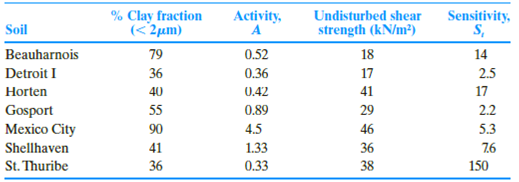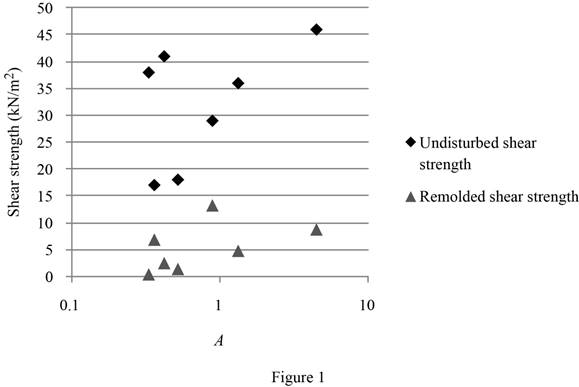
The properties of seven different clayey soils are shown below (Skempton and Northey, 1952). Investigate the relationship between the strength and plasticity characteristics by performing the following tasks:
a. Estimate the plasticity index for each soil using Skempton’s definition of activity [Eq. (4.28)].
b. Estimate the probable mineral composition of the clay soils based on PI and A (use Table 4.3)
c. Sensitivity (St) refers to the loss of strength when the soil is remolded or disturbed. It is defined as the ratio of the undisturbed strength (τf-undisturbed) to the remolded strength (τf-remolded)) at the same moisture content [Eq. (12.49)]. From the given data, estimate τf-remolded for the clay soils.
d. Plot the variations of undisturbed and remolded shear strengths with the activity, A, and explain the observed behavior.

(a)
Find the plasticity index for each soil using Skempton’s definition of activity.
Explanation of Solution
Determine the plasticity index of the Beauharnais soil using the relation.
Here, A is an activity.
Substitute 0.52 for A and 79 for % of clay–size fraction, by weight.
Similarly, calculate the plasticity index for the remaining soils.
Determine the remolded shear strength of the Beauharnais soil using the relation.
Here,
Substitute
Similarly, calculate the remolded shear strength of the remaining soils.
Summarize the calculated values of plasticity index and the remolded shear strength as in Table 1.
| Soil | % Clay fraction | Activity A | Plasticity Index |
| Beauharnois | 79 | 0.52 | 41.08 |
| Detroit I | 36 | 0.36 | 12.96 |
| Horten | 40 | 0.42 | 16.80 |
| Gosport | 55 | 0.89 | 48.95 |
| Mexico City | 90 | 4.5 | 405 |
| Shell haven | 41 | 1.33 | 54.53 |
| St.Thuribe | 36 | 0.33 | 11.88 |
(b)
Find the probable mineral composition of the clay soils based on PI and A.
Explanation of Solution
Determine the probable mineral composition of the clay soils based on PI and A.
Refer Table 4.3, “Typical values of liquid limit, plastic limit, and activity of some clay minerals” in the textbook.
Take the mineral composition of the Beauharnois soil as Illite for the activity value of 0.52 and the plasticity index value of 41.08.
Therefore, the mineral composition of Beauharnois soil is Illite.
Similarly, calculate the probable mineral composition of the remaining soils.
Summarize the calculated values of mineral composition as in Table (2).
| Soil | Activity A | Plasticity Index | Mineral composition |
| Beauharnois | 0.52 | 41.08 | Illite |
| Detroit I | 0.36 | 12.96 | Kaolinite |
| Horten | 0.42 | 16.80 | Kaolinite |
| Gosport | 0.89 | 48.95 | Illite |
| Mexico City | 4.5 | 405 | Montmorillonite |
| Shell haven | 1.33 | 54.53 | Montmorillonite |
| St.Thuribe | 0.33 | 11.88 | Kaolinite |
(c)
Find the remoulded shear strength of the clay soil.
Explanation of Solution
Determine the remoulded shear strength of the Beauharnais soil using the relation.
Here,
Substitute
Similarly, calculate the remolded shear strength of the remaining soils.
Summarize the calculated values of remolded shear strength as in Table 3.
| Soil | Activity A | Undisturbed Shear strength | Sensitivity |
Remoulded Shear strength |
| Beauharnois | 0.52 | 18 | 14 | 1.3 |
| Detroit I | 0.36 | 17 | 2.5 | 6.8 |
| Horten | 0.42 | 41 | 17 | 2.4 |
| Gosport | 0.89 | 29 | 2.2 | 13.2 |
| Mexico City | 4.5 | 46 | 5.3 | 8.7 |
| Shell haven | 1.33 | 36 | 7.6 | 4.7 |
| St.Thuribe | 0.33 | 38 | 150 | 0.3 |
(d)
Plot the variations of undisturbed and remolded shear strengths with the activity A.
Explanation of Solution
Refer Table 3.
Plot the graph between the undisturbed, remolded shear strengths with the activity A as in Figure 1.

The shear strength of the clay obtains from two components, one is cohesion, which is the cementing force between particles, and second one is frictional resistance, which is mainly due to the particle movement of one particle over another. The cohesion contribution is greater to the shear strength, when the clay activity is greater. Although no reliable correlation can be developed from Figure 1, both the undisturbed and remolded shear strengths certainly show increasing trends as the activity increases.
Want to see more full solutions like this?
Chapter 4 Solutions
Bundle: Principles Of Geotechnical Engineering, Loose-leaf Version, 9th + Mindtap Engineering, 2 Terms (12 Months) Printed Access Card
- (A): As shown in the rig. A hydraulic jump was occurred in a rectangular channel,the velocity of flow before and after the jump equal to 8 m/s and 2 m/s respectively. Find: The energy dissipation for the jump (AE) and what is the name of this jump. V1-8 m/s -V2-2 m/sarrow_forwardA cylinder of fluid has dimensions of 0.2 ft in diameter by 0.45 ft high. If the weight of thefluid is 0.55 lb , determine the specific gravity and density of fluid.arrow_forwardA cylinder of fluid has dimensions of 0.2 ft in diameter by 0.45 ft high. If the weight of thefluid is 0.55 lb , determine the specific gravity and density of fluid.arrow_forward
- A cylinder of fluid has dimensions of 0.2 ft in diameter by 0.45 ft high. If the weight of thefluid is 0.55 lb , determine the specific gravity and density of fluid.arrow_forwardDraw the shear and bending moment diagrams and find the immediate deflection for a simply supported beam of length 20 ft. with the same live load at ½ span and cross-section as the previous problem. Assume a reasonable Modulus of Elasticity and concrete self-weight. Hint: You may look online for typical concrete self-weights and compressive strengths. You may also use the ACI 318 Code equation for the Modulus of Elasticity shown below, and the supplied Design Aids.arrow_forwardProblem 4. A major transmission pathway of the novel coronavirus disease 2019 (COVID- 19) is through droplets and aerosols produced by violent respiratory events such as sneezes and coughs (Fig. 1). For the purpose of providing public health guidelines, we would like to estimate the amount of time it takes for these droplets to settle from air to the ground. The relevant parameters are the settling time (ts), the initial height of the droplets (H), gravitational acceleration (g), density of the droplets (pa), radius of the droplets (R), as well as dynamic viscosity of the ambient air (Pair). Use dimensional analysis and the Buckingham theorem to answer the following questions: 1. Find the independent dimensionless parameters using the table method. Then, express the settling time as a function of the other relevant parameters. Your solution should match the physical intuition that the settling time scales linearly with the initial height. 2. How would the settling change if the…arrow_forward
- Question 4 An engineer is assigned to design a 25-stories office building which has a building height of 75 m. Reinforced concrete shear wall system as shown in Figure Q1(a) is adopted to resist the lateral loads. The shear wall is of thickness t = 350 mm and length L = 8.5 m. Use the following data: Young's modulus of concrete E = 28 kN/mm² and the lateral load intensity w = 1.20 kN/m². Assuming the frontal width of the building façade is 15 m is facing the wind force which in turn transmitting the wind force to the shear wall system, estimate the total value of sway A at the roof level. Question 5 For the Shear Wall in Question 4, if the total ultimate gravity load of the building acted on shear wall is 6000 KN, using a partial factor of 1.2 for the wind load, calculate the stress on the extreme right corner of the shear wall at first storey level. (A) 9.46 mm (B) 189.26 mm (C) 14.20 mm (D) 141.95 mm STOREY FLOOR LEV Shear wall Figure Q1(a) (A) 3.228 N/sq mm (B) 14.029 N/sq mm 75 m…arrow_forwardQuestion 4 An engineer is assigned to design a 25-stories office building which has a building height of 75 m. Reinforced concrete shear wall system as shown in Figure Q1(a) is adopted to resist the lateral loads. The shear wall is of thickness t = 350 mm and length L = 8.5 m. Use the following data: Young's modulus of concrete E = 28 kN/mm² and the lateral load intensity w = 1.20 kN/m². Assuming the frontal width of the building façade is 15 m is facing the wind force which in turn transmitting the wind force to the shear wall system, estimate the total value of sway A at the roof level. Question 6 If the similar building in Question 4 is designed using rigid frame method is to be designed to ensure the sway is within the allowable limit. If the building width is B, and with the same building height H=75m. Using a rough estimation method, calculate the maximum allowable deflection A at the roof level. (A) 9.46 mm (B) 189.26 mm (C) 14.20 mm 町 141.95 mm 1ST STOREY FLOOR LEV. Shear wall…arrow_forwardWhat are the biggest challenges estimators' face during the quantity takeoff and pricing phases?arrow_forward
- Question IV (30%): A 22 m thick normally consolidated clay layer has a load of 150 kPa applied to it over a large areal extent. The clay layer is located below a 3.5 m thick granular fill (p= 1.8 Mg/m³). A dense sandy gravel is found below the clay. The groundwater table is located at the top of the clay layer, and the submerged density of the clay soil is 0.95 Mg/m³. Consolidation tests performed on 2.20 cm thick doubly drained samples indicate the time for 50% consolidation completed as t50 = 10.5 min for a load increment close to that of the loaded clay layer. Compute the effective stress in the clay layer at a depth of 16 m below the ground surface 3.5 years after the application of the load.arrow_forward13-3. Use the moment-distribution method to determine the moment at each joint of the symmetric bridge frame. Supports at F and E are fixed and B and C are fixed connected. Use Table 13-2. The modulus of elasticity is constant and the members are each 0.25 m thick. The haunches are parabolic. *13-4. Solve Prob. 13-3 using the slope-deflection equations. 13 0.5 m 1 m 64 kN/m D BC 1.5 m 2.25 m 2 m 6.25 m -0.5 m E -7.5 m -10 m- -7.5 m. Probs. 13-3/4arrow_forward2. Find the equivalent concentrated load(s) for the bags of cement stacked on the dock as shown here. Each bag weighs 100 lbs and is 12 inches long. Draw the loading conditions for each showing the equivalent concentrated load(s). 1 bag = 100lbs L= 12 ft L= 6 ft L= 8ftarrow_forward
 Principles of Geotechnical Engineering (MindTap C...Civil EngineeringISBN:9781305970939Author:Braja M. Das, Khaled SobhanPublisher:Cengage Learning
Principles of Geotechnical Engineering (MindTap C...Civil EngineeringISBN:9781305970939Author:Braja M. Das, Khaled SobhanPublisher:Cengage Learning Principles of Foundation Engineering (MindTap Cou...Civil EngineeringISBN:9781337705028Author:Braja M. Das, Nagaratnam SivakuganPublisher:Cengage Learning
Principles of Foundation Engineering (MindTap Cou...Civil EngineeringISBN:9781337705028Author:Braja M. Das, Nagaratnam SivakuganPublisher:Cengage Learning Fundamentals of Geotechnical Engineering (MindTap...Civil EngineeringISBN:9781305635180Author:Braja M. Das, Nagaratnam SivakuganPublisher:Cengage Learning
Fundamentals of Geotechnical Engineering (MindTap...Civil EngineeringISBN:9781305635180Author:Braja M. Das, Nagaratnam SivakuganPublisher:Cengage Learning Principles of Foundation Engineering (MindTap Cou...Civil EngineeringISBN:9781305081550Author:Braja M. DasPublisher:Cengage Learning
Principles of Foundation Engineering (MindTap Cou...Civil EngineeringISBN:9781305081550Author:Braja M. DasPublisher:Cengage Learning Construction Materials, Methods and Techniques (M...Civil EngineeringISBN:9781305086272Author:William P. Spence, Eva KultermannPublisher:Cengage Learning
Construction Materials, Methods and Techniques (M...Civil EngineeringISBN:9781305086272Author:William P. Spence, Eva KultermannPublisher:Cengage Learning Traffic and Highway EngineeringCivil EngineeringISBN:9781305156241Author:Garber, Nicholas J.Publisher:Cengage Learning
Traffic and Highway EngineeringCivil EngineeringISBN:9781305156241Author:Garber, Nicholas J.Publisher:Cengage Learning





